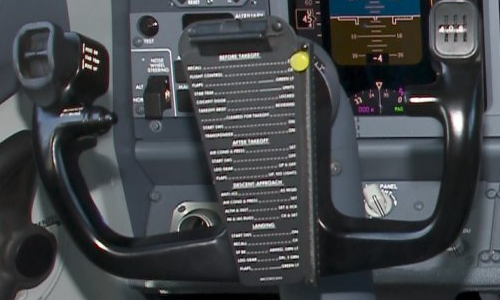¶ Intoduction
The yoke is an essential component of an aircraft's control system, providing the pilot with the means to manipulate the aircraft's flight path and attitude. It is typically located in the cockpit, within easy reach of the pilot, and is connected to the aircraft's control surfaces through a series of mechanical linkages.

¶ Functions
The primary function of the yoke is to control the aircraft's pitch and roll movements. Pitch refers to the up and down movement of the aircraft's nose, while roll refers to the side-to-side movement. By manipulating the yoke, the pilot can adjust these movements and steer the aircraft in the desired direction.
The yoke consists of a control column or wheel, which is usually positioned between the pilot's legs or in front of them. The control column is a vertical lever that is moved forward and backward to control the pitch of the aircraft. By pulling back on the control column, the pilot can raise the nose of the aircraft, causing it to climb. Conversely, pushing the control column forward lowers the nose, causing the aircraft to descend.
The control wheel, on the other hand, is a horizontal steering device that is turned left or right to control the roll of the aircraft. By turning the control wheel to the left, the pilot can bank the aircraft to the left, initiating a turn in that direction. Similarly, turning the control wheel to the right banks the aircraft to the right.
In addition to controlling pitch and roll, the yoke may also have additional controls integrated into it. These controls may include buttons or switches for operating various systems within the aircraft, such as radio communications, navigation equipment, or autopilot functions. This allows the pilot to access these systems without having to remove their hands from the yoke.
¶ Mechanisms
The yoke is connected to the aircraft's control surfaces through a series of mechanical linkages. These linkages transmit the pilot's inputs from the yoke to the appropriate control surfaces, such as the ailerons, elevators, and rudder. The ailerons are located on the wings and are responsible for controlling the roll of the aircraft. The elevators, located on the tail, control the pitch. The rudder, also located on the tail, controls the yaw movement of the aircraft.
When the pilot manipulates the yoke, the mechanical linkages transmit these inputs to the control surfaces, causing them to move accordingly. For example, pulling back on the control column will cause the elevators to move upward, pitching the nose of the aircraft up. This will result in an increase in altitude and a climb. Similarly, turning the control wheel to the right will cause the ailerons to move, banking the aircraft to the right and initiating a turn in that direction.
The yoke is designed to provide the pilot with precise control over the aircraft's movements. It is usually connected to a system of springs and dampers that provide resistance and feedback to the pilot's inputs. This allows the pilot to feel the aircraft's response to their commands and make adjustments as necessary.
¶ Safety
In addition to its primary function of controlling pitch and roll, the yoke also plays a crucial role in flight safety. It is equipped with various indicators and warning lights that provide the pilot with important information about the aircraft's systems and status. For example, there may be an indicator that shows the position of the aircraft's flaps or landing gear, or a warning light that alerts the pilot to an engine malfunction.
¶ Сonclusion
The yoke is an intuitive and reliable control device that has been used in aviation for many years. It provides pilots with a familiar and comfortable means of controlling the aircraft, allowing for precise and responsive maneuvering. Whether flying a small single-engine airplane or a large commercial jet, pilots rely on the yoke to safely navigate through the skies.
VID 582348 - Creation